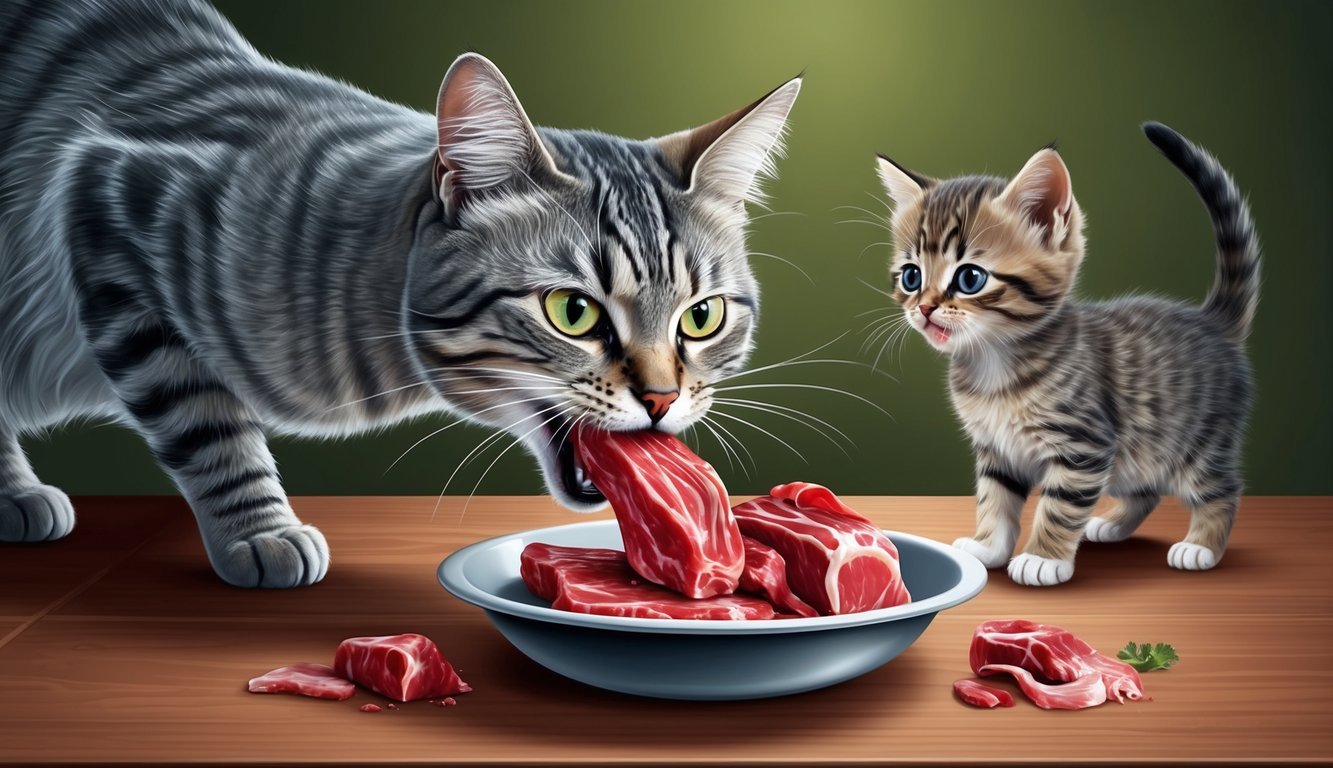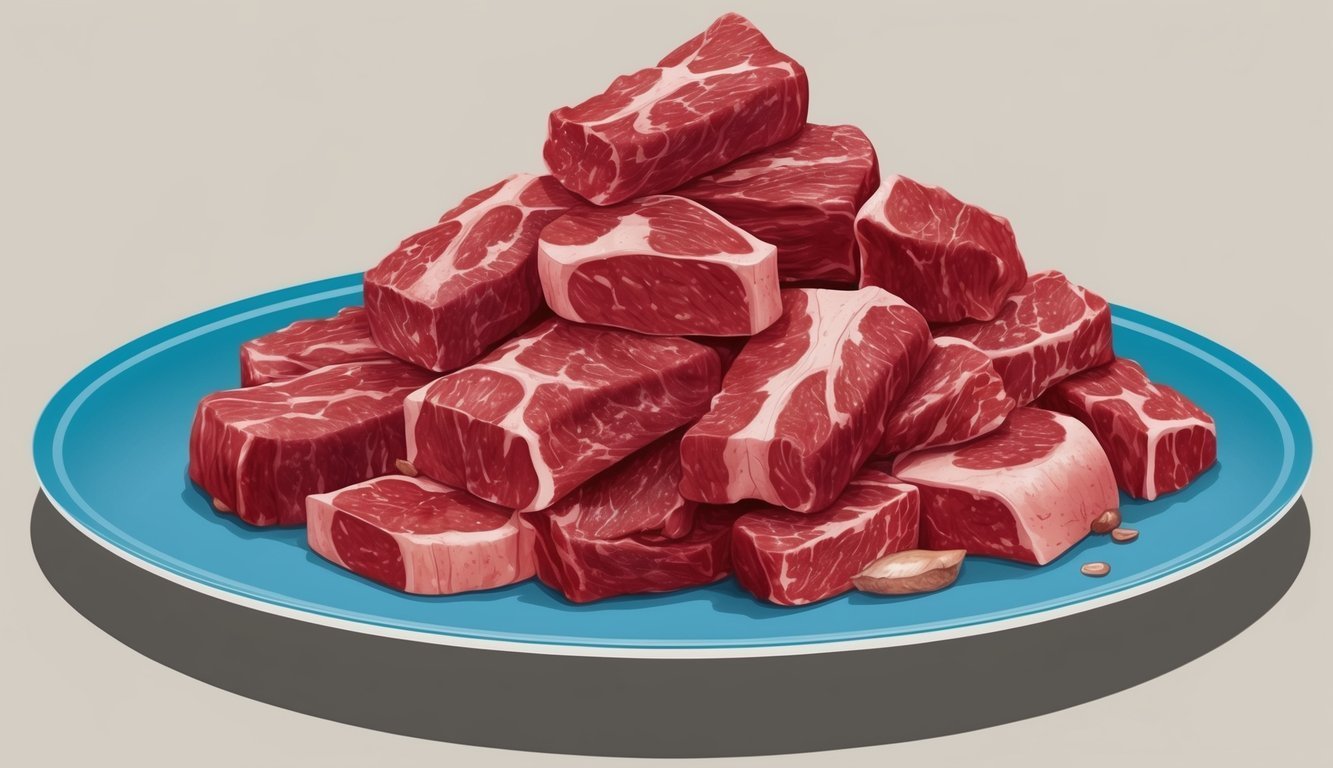Feeding your cat a raw meat diet can seem like a daunting decision, but understanding it can lead to potential benefits for your feline friend.
A raw meat diet may provide cats with high-quality protein and essential nutrients that closely resemble what they would eat in the wild.
This approach emphasizes raw muscle meat, organ meat, and bones, aiming to meet your cat’s natural dietary needs.
While there are compelling reasons to consider this feeding method, it’s important to weigh the potential risks and ensure you’re informed about proper selection and preparation techniques.
Transitioning your cat to a raw diet requires careful planning and awareness of food safety to avoid health issues such as bacterial contamination or nutritional imbalances.
As you explore whether a raw meat diet is suitable for your pet, it’s essential to gather all the relevant information to make a wise choice that aligns with their health and well-being.
The journey into raw feeding may help you understand better nutrition for your cat while also addressing common misconceptions along the way.
Key Takeaways
- A raw meat diet can offer high-quality nutrition for your cat.
- Proper preparation and safety measures are crucial when feeding raw meat.
- Understanding your cat’s dietary needs is key to successful raw feeding.
Understanding Feline Nutrition
To ensure your cat thrives, it’s essential to grasp their unique nutritional needs.
As obligate carnivores, cats require a diet rich in animal-based nutrients.
This section will explore their dietary requirements and the key nutrients that support their health.
Obligate Carnivores and Their Diet
Cats are obligate carnivores, which means they depend on nutrients found in animal tissues.
Unlike dogs, cats cannot thrive on a plant-based diet.
Their bodies have evolved to metabolize proteins and fats from meat efficiently.
This diet should primarily consist of:
- Muscle meat
- Organ meat
- Bones
Each component plays a vital role in meeting your cat’s nutritional needs.
For instance, muscle meat provides protein, while organ meat supplies essential vitamins and minerals.
The inability to convert certain nutrients from plant sources highlights the importance of a meat-based diet.
Insufficient protein or vital fatty acids can lead to nutritional deficiencies, negatively impacting your cat’s overall health.
Essential Nutrients for Cats
Felines require specific nutrients to maintain optimal health.
Among these, taurine is critical.
This amino acid supports heart function, vision, and reproductive health.
Unlike many animals, cats cannot produce enough taurine, making it essential to add it through their diet.
Cats also need:
- Protein: Builds and repairs tissues.
- Fat: Provides energy and supports cell function.
- Vitamins and Minerals: Critical for various bodily functions.
A lack of these nutrients can result in deficiencies.
For example, insufficient taurine may lead to heart disease, while a protein deficiency can cause muscle wastage.
Providing a balanced diet with high-quality meat sources ensures your cat gets the necessary nutrients to thrive.
Always consult your veterinarian when considering dietary changes or special diets.
The Raw Meat-Based Diet Concept

The raw meat-based diet concept revolves around feeding cats uncooked animal products, aiming to align their nutrition with what their ancestors consumed.
This approach has gained popularity among cat owners, prompting examination of its philosophy and comparisons with commercial cat food.
History and Philosophy of Raw Feeding
The idea of feeding raw meat to pets is rooted in the belief that it mirrors the diet of wild felines.
Proponents argue that cats are obligate carnivores, which means they thrive on animal protein and nutrients found in uncooked meat.
The BARF diet, short for Biologically Appropriate Raw Food, emerged as a structured method for feeding pets raw food.
This approach encourages a combination of raw meat, bones, and sometimes fruits or vegetables.
Supporters of raw feeding emphasize its potential benefits, including improved coat condition and reduced waste odor.
Commercial Cat Food Versus Raw Diets
When comparing commercial cat food to raw diets, a significant aspect is nutritional adequacy.
Most commercial cat foods comply with AAFCO standards, which outline the necessary nutrients for feline health.
These foods are designed for convenience and nutritional balance.
In contrast, raw meat-based diets often lack certain vitamins and minerals unless carefully planned.
It’s essential to ensure that a raw diet contains all necessary nutrients.
Additionally, the risk of bacterial contamination can be higher in raw feeding.
Therefore, careful sourcing and handling of meat are crucial to prevent health issues.
Health Benefits of Raw Meat for Cats
Feeding your cat a raw meat diet can offer several health benefits that improve their overall well-being.
Focused on digestibility and a stronger immune system, these advantages may lead to noticeable changes in your cat’s health.
Improvement in Digestibility and Fecal Output
A raw meat diet closely resembles what wild cats would eat, making it more natural for them.
This familiarity helps improve digestibility, as cats have shorter digestive tracts designed to process raw meat efficiently.
- Less Gas and Bloating: Many cat owners report a decrease in gastrointestinal upset when switching to raw diets.
- Reduced Fecal Volume: Cats on raw diets often produce smaller, less odorous stools.
This can be attributed to more efficient nutrient absorption.
Enhanced Immunity and Overall Well-being
A great advantage of feeding raw meat is the potential boost to your cat’s immune system.
Raw diets can enhance nutrient intake, providing essential vitamins and minerals.
- Balanced Nutrients: Ingredients like muscle meat and organ meat deliver essential nutrients that support immune health.
- White Blood Cell Increase: Studies show a significant rise in beneficial white blood cells in cats eating raw meat, which can help fend off infections.
You may notice improved energy levels and a shinier coat as a result of these dietary changes.
Potential Risks of Feeding Cats Raw Meat
Feeding your cat raw meat may seem appealing, but several risks accompany this dietary choice.
Two primary concerns are pathogens and bacterial contamination, as well as parasite transmission and the risk of thiamine deficiency.
Pathogens and Bacterial Contamination
Raw meat can harbor harmful pathogens like Salmonella, E. coli, and Listeria.
These bacteria can lead to foodborne illnesses not just in cats, but also in humans handling the food.
If your cat consumes contaminated meat, they may experience symptoms such as vomiting, diarrhea, and lethargy.
It can also pose serious health risks if the bacteria spread to your household.
Cross-contamination is another issue.
Using the same surfaces or utensils for raw meat and other foods can spread pathogens, increasing the risk of infection for both you and your cat.
Keeping kitchens clean is essential.
Parasite Transmission and Thiamine Deficiency
Raw meat can also carry parasites, which can infect your cat.
Common parasites include roundworms and tapes that may lead to gastrointestinal issues.
Additionally, some raw fish contain an enzyme called thiaminase, which breaks down thiamine, or vitamin B1.
A deficiency in thiamine can cause severe neurological issues and even be life-threatening.
It’s crucial to ensure that any raw meat fed is sourced from reputable suppliers to minimize the risk of these pathogens and parasites.
Adapting your cat’s diet requires careful consideration of both immediate and long-term health implications.
Selecting and Preparing Raw Meat for Cats
When it comes to raw feeding, ensuring safety and nutritional value is key.
You’ll want to handle and store meat properly, choose the right cuts, and know how to incorporate bones and taurine, all of which are essential for your cat’s health.
Safe Meat Handling and Storage
Start by selecting high-quality meat.
Always choose products from reputable sources and inspect for freshness.
Storage Tips:
- Keep It Cold: Refrigerate raw meat immediately. It should be stored at 40°F (4°C) or below.
- Freeze If Needed: If you buy in bulk, freeze smaller portions in airtight bags or containers. This prevents freezer burn and maintains quality.
- Thaw Safely: Thaw frozen meat in the fridge or under cold running water. Avoid leaving it out at room temperature to minimize bacterial growth.
Always wash your hands and utensils thoroughly after handling raw meat.
This simple step reduces the risk of bacteria spreading.
Appropriate Cuts and Portions
When choosing meat cuts, look for muscle meats like chicken breast, turkey, or beef.
These provide essential nutrients without excessive fat.
Portion Guidelines:
- Daily Serving Size: Roughly 2-4 ounces per meal, varying by your cat’s weight and activity level.
- Variety Matters: Rotate different types of meat to ensure a balanced intake of nutrients.
Consider consulting with a veterinarian or a feline nutritionist to create a tailored feeding plan.
This ensures that your cat receives well-rounded nutrition.
Incorporating Bones and Taurine
Bone is crucial for dental health and provides natural calcium.
Safe Bone Choices:
- Raw Bones Only: Always use raw, not cooked bones, as cooked bones can splinter and cause injury.
- Types of Bones: Chicken necks and wings are popular, but larger bones like turkey necks can also be included.
Taurine is an essential amino acid for cats.
Many raw meat options contain taurine, but some may require supplementation.
Always check meat type and portion to ensure your cat meets its taurine needs regularly.
Transitioning to a Raw Diet for Cats
Switching to a raw diet for your cat requires a thoughtful approach to ensure they adjust smoothly and maintain their health.
Gradual introduction and close observation play essential roles in this transition.
Introducing Raw Foods Gradually
Start by incorporating raw foods slowly into your cat’s diet.
A good method is the two-bowl approach, where you place a small percentage of raw food in one bowl while keeping the majority of their current food in another.
For instance, you could begin with 10% raw food and 90% commercial cat food.
Gradually increase the raw portion over a few weeks.
This helps your cat adapt to new textures and flavors without causing digestive upset.
If your cat is hesitant, consider blending some raw meat into their favorite wet food.
This can encourage them to try raw options.
Regularly introduce different types of meats, like chicken or fish, to keep the diet varied and appealing.
Monitoring Cat’s Health and Behavior
As your cat transitions, keep a close eye on their health and behavior.
Watch for any signs of gastrointestinal upset, like vomiting or diarrhea, which could indicate a need for a more gradual approach.
You can also monitor their energy levels and overall mood.
A successful transition should lead to improved vitality.
It’s also wise to regularly check their weight and adjust portions accordingly, ensuring they’re not over or underfed.
Don’t hesitate to consult your veterinarian for guidance tailored to your cat’s specific needs.
Tracking how well your cat is adjusting can help you fine-tune their raw diet, ensuring it supports their health effectively.
Debunking Myths about Raw Feeding

There are many misconceptions surrounding raw feeding for cats.
It’s important to clarify these myths to help you make informed decisions about your cat’s diet.
Raw Meat Diet versus Kibble
A common myth is that kibble is better for your cat’s dental health than a raw meat diet.
Some people think kibble helps clean teeth, but this isn’t as effective as proponents claim.
The idea that dry food scrapes off plaque is misleading; raw diets including bones can actually reduce plaque and tartar buildup more effectively.
Cats are anatomically designed to digest raw meat.
Their stomachs are highly acidic, allowing them to handle bacteria more efficiently than humans.
A raw diet typically includes muscle meat, organ meat, and bones.
These components provide essential nutrients that kibble often lacks.
Dispelling Fears about Raw Fish
Many cat owners worry that raw fish poses health risks.
While some fish can contain harmful parasites or bacteria, choosing fresh, high-quality fish can mitigate these concerns.
Raw fish can be a good protein source when included properly in your cat’s diet.
It’s essential to rotate proteins, so your cat doesn’t eat one type exclusively.
Avoid fish too high in mercury, like tuna, and ensure the fish is suitable for feline consumption.
A balanced raw diet may include small amounts of raw fish alongside other protein sources to provide variety and keep your cat healthy.
Frequently Asked Questions

When considering a raw meat diet for your cat, you might have some questions.
Here are specific answers to the most common concerns about feeding your feline raw meat.
Can I feed my cat raw meat from the grocery store?
Yes, you can feed your cat raw meat from the grocery store, but caution is needed.
Ensure the meat is fresh and sourced from a reputable supplier.
Always avoid processed meats, as they may contain additives that are not safe for your cat.
What’s the best type of raw meat to give to cats?
The best types of raw meat include chicken, turkey, and beef.
These meats are closer to a cat’s natural diet.
Organ meats, like liver or kidney, can also be beneficial but should be fed in moderation.
How do I safely introduce raw meat into my cat’s diet?
Start by mixing a small amount of raw meat with your cat’s regular food.
Gradually increase the raw meat portion over several days.
Monitoring their reaction and digestion is essential to ensure they handle the transition well.
Is it safe for cats to eat raw meat every day?
Feeding your cat raw meat daily can be safe if balanced correctly.
It’s important to include a variety of proteins and ensure they receive necessary nutrients.
Consult a vet to establish a well-rounded diet that fits your cat’s needs.
Do vets recommend including raw meat in a cat’s diet?
Some vets support raw meat diets, while others express concern about safety and balance.
It’s essential to consult your veterinarian to discuss options tailored to your cat’s health and lifestyle.
They can help you assess the benefits and potential risks.
How can raw meat diets impact a cat’s health?
Raw meat diets can improve digestion and coat conditions.
However, there’s a risk of bacterial contamination.
Ensuring proper food handling and maintaining a balanced diet is crucial for your cat’s overall health.


